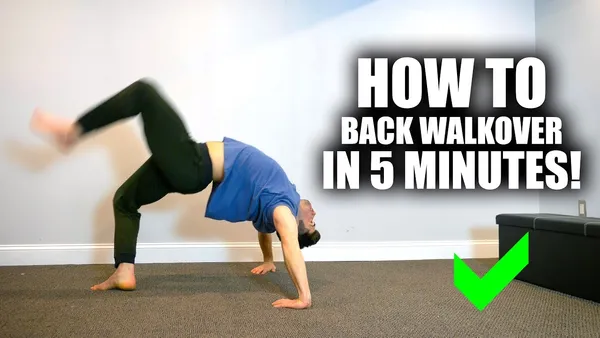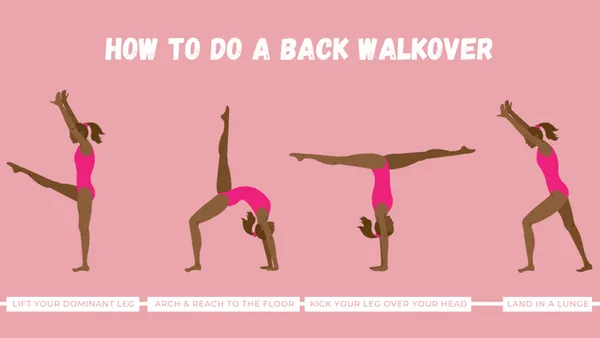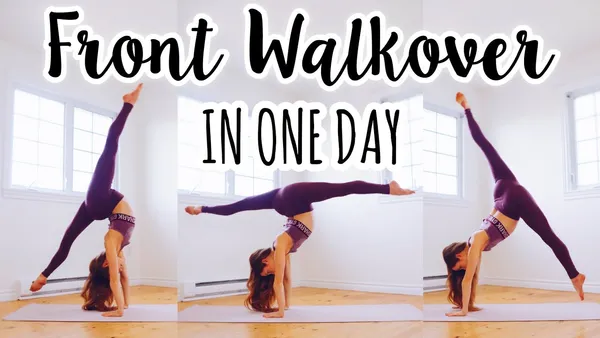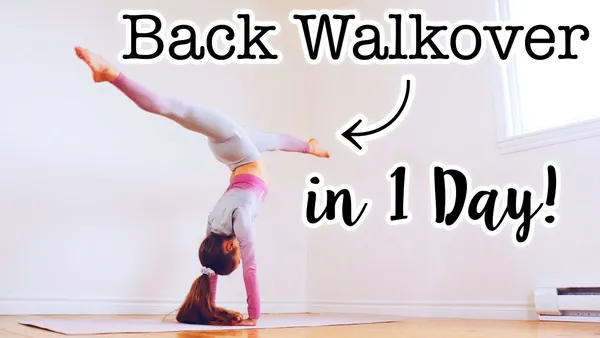Table of Contents
Welcome to Kizworld, your ultimate guide to mastering the art of the walkover. This comprehensive tutorial will equip you with the knowledge and techniques necessary to execute this fundamental gymnastic maneuver. From understanding the basics to perfecting the advanced steps, we'll take you on a journey towards gymnastic excellence. Discover How to do a walkover, unlock your potential, and elevate your fitness routine to new heights.
How to do a walkover: Master the Basics of Gymnastics
I. How to Prepare for a Walkover
How to Prepare for a Walkover
1. Warm Up
Before attempting a walkover, it's crucial to warm up your body properly to prevent injuries. Start with light cardio exercises such as jogging or jumping jacks to increase your heart rate and blood flow. Follow this with dynamic stretches that target the muscles involved in the walkover, including the hamstrings, quadriceps, and shoulders. Hold each stretch for 30 seconds and repeat it three times.
For more information on dynamic stretches read our complete guide: How to Improve Your Flexibility and Mobility with Gymnastics
Exercise | Sets | Reps |
|---|---|---|
Jogging or Jumping Jacks | 1 | 3-5 minutes |
Hamstring Stretch | 3 | 30 seconds |
Quadriceps Stretch | 3 | 30 seconds |
Shoulder Stretch | 3 | 30 seconds |
2. Practice the Cartwheel
The cartwheel is a fundamental gymnastic skill that serves as a stepping stone to the walkover. It helps you develop the coordination, balance, and body awareness required for the walkover. Start by practicing the cartwheel on a soft surface like a mat or grass. Focus on keeping your body straight and your weight distributed evenly between your hands and feet.
Visit our post: How to Do a Cartwheel
- Stand with your feet shoulder-width apart, arms extended overhead.
- Take a small step forward with your right foot and plant your hands on the ground, shoulder-width apart.
- Kick your left leg up and over your right leg, while simultaneously pushing off with your right foot.
- Land on your left foot and continue the rotation, bringing your right leg over your left.
- Finish the cartwheel by standing upright with your arms extended overhead.
3. Master the Handstand
The handstand is another essential skill for the walkover. It strengthens your upper body and core muscles, which are crucial for maintaining balance and control during the walkover. Begin by practicing the handstand against a wall for support. As you progress, gradually move away from the wall until you can hold the handstand without support.
Check out our guide: How to Do a Handstand
- Start with a wall for support.
- Place both hands on the ground, shoulder-width apart, fingers spread.
- Bend your knees and kick your legs up, one at a time.
- Straighten your body and hold the handstand for as long as you can.
- To come out of the handstand, bend your knees and lower your legs one at a time.
4. Combine the Cartwheel and Handstand
Once you've mastered the cartwheel and handstand individually, it's time to combine them to create the walkover. Start by practicing the walkover on a soft surface. Begin with a cartwheel, then transition into a handstand. Hold the handstand for a few seconds, then lower your body back down into a cartwheel, and finish by standing upright.
For more details into the cartwheel and handstand, read more: The Most Common Gymnastics Mistakes and How to Fix Them
- Start with a cartwheel.
- Transition into a handstand.
- Hold the handstand for a few seconds.
- Lower your body back down into a cartwheel.
- Stand upright to finish the walkover.
5. Perfect the Walkover
With practice, you'll be able to perform the walkover smoothly and confidently. Focus on maintaining good form throughout the entire movement. Keep your body straight, your weight evenly distributed, and your eyes fixed on a spot in front of you. As you become more comfortable with the walkover, you can try it on different surfaces and even add variations, such as the roundoff walkover or the back handspring walkover.
Check out this related post: The Top Gymnastics Competitions and Events
II. How to Perform a Walkover
How to Perform a Walkover
1. Warm Up
Before attempting a walkover, it's crucial to warm up your body to prevent injuries. Start with light cardio exercises like jogging or jumping jacks to get your heart rate up. Follow this with dynamic stretches, focusing on your legs, hips, and shoulders. Include exercises like leg swings, hip circles, and arm circles to prepare your muscles for the walkover.
Related: How to Do a Handstand: A Step-by-Step Guide to Mastering the Art of Balance
2. Practice the Cartwheel
The cartwheel is a fundamental skill that serves as a building block for the walkover. Begin by standing with your feet shoulder-width apart and your arms extended to the sides. Bend your knees slightly and swing your right leg forward, placing your hands on the ground in front of you. Quickly kick your left leg over your head and land on your feet, maintaining your balance. Practice the cartwheel in both directions to develop coordination and body awareness.
Related: The Benefits of Gymnastics for Kids: Building Strength, Flexibility, and Confidence
3. Master the Handstand
The handstand is another essential skill for performing a walkover. Start by standing with your feet shoulder-width apart and your arms extended overhead. Bend your knees slightly and place your hands on the ground, shoulder-width apart. Kick your legs up one at a time, aiming to form a straight line with your body. Hold the handstand for a few seconds, maintaining your balance and control. Practice the handstand regularly to build strength and stability in your upper body.
Related: The Best Gymnastics Equipment for Home Use: Creating a Safe and Fun Training Space
4. Combine the Cartwheel and Handstand
Once you've mastered the cartwheel and handstand, it's time to combine them to create the walkover. Start by performing a cartwheel, but instead of landing on your feet, transition into a handstand. Hold the handstand for a moment, then slowly lower your body back down to the ground, landing on your feet. Practice this combination move until you can perform it smoothly and confidently.
Related: How to Improve Your Flexibility and Mobility with Gymnastics: Stretching Exercises and Techniques
5. Perfect the Walkover
With consistent practice, you'll eventually be able to perform the walkover seamlessly. Focus on maintaining proper form throughout the move, keeping your body straight and your core engaged. As you gain more confidence, you can try performing the walkover on different surfaces, such as a mat or a balance beam. You can also add variations to the walkover, such as the round-off walkover or the back walkover, to challenge yourself and expand your gymnastic skills.
Related: The History and Evolution of Gymnastics: From Ancient Greece to Modern Competitions
Mistake | Correction |
Bending your knees during the walkover | Keep your legs straight throughout the move. |
Leaning forward or backward during the walkover | Maintain an upright posture and keep your body straight. |
Not engaging your core | Engage your core muscles to stabilize your body and prevent arching your back. |
Rushing through the move | Perform the walkover slowly and controlled to ensure proper form and technique. |
Related: How to Choose the Right Gymnastics Leotard: Factors to Consider and Tips for a Perfect Fit
III. Tips for Beginners
- Start with the basics: Master the cartwheel and handstand before attempting the walkover.
- Practice regularly: Consistent practice is key to improving your skills and gaining confidence.
- Focus on proper form: Pay attention to your body alignment and technique to avoid injuries and improve your performance.
- Don't be afraid to ask for help: If you're struggling with a particular move, seek guidance from a qualified gymnastics coach or instructor.
- Have fun: Enjoy the process of learning and improving your gymnastic skills.
Related: The Most Common Gymnastics Injuries and How to Prevent Them: Safety Tips and Techniques
IV. Variations of the Walkover
- Round-off walkover: This variation involves performing a round-off (a backward handspring) into a walkover.
- Back walkover: This variation involves performing a walkover backward, starting with your back to the direction of travel.
- Aerial walkover: This advanced variation involves performing a walkover while airborne, typically as part of a tumbling pass.
V. Conclusion
Mastering the walkover is a rewarding achievement in gymnastics, requiring dedication, practice, and proper technique. By following the steps outlined in this guide, you can safely and effectively learn how to perform a walkover, unlocking new possibilities in your gymnastic journey. Remember to warm up properly, practice regularly, and focus on perfecting your form. With patience and perseverance, you'll be able to execute the walkover with grace and confidence.
Related: The Best Gymnastics Exercises for Core Strength: Building a Solid Foundation for Gymnastic Skills
VI. Common Mistakes to Avoid When Doing a Walkover
Common Mistakes to Avoid When Doing a Walkover
1. Not Warming Up Properly
Warming up your body before attempting a walkover is crucial to prevent injuries. Dynamic stretches, such as leg swings and arm circles, help prepare your muscles for the movement. Including a light jog or jumping jacks in your warm-up routine can elevate your heart rate and increase blood flow to your muscles.
- Perform dynamic stretches to prepare your muscles.
- Include light cardio to elevate your heart rate.
Read more about the benefits of warming up before exercise.
2. Rushing the Movement
Attempting a walkover too quickly can lead to loss of control and potential injury. Take your time and focus on executing each step of the movement correctly. Rushing the walkover can also result in poor form, which can hinder your progress and increase the risk of injury.
- Focus on executing each step correctly.
- Avoid rushing the movement.
Learn more about the importance of proper form in gymnastics.
3. Not Engaging Your Core
Engaging your core muscles is essential for maintaining stability and control during a walkover. Tighten your abdominal muscles and draw your belly button towards your spine. This will help protect your lower back and prevent injuries. Additionally, engaging your core will help you generate the power needed to complete the walkover successfully.
- Tighten your abdominal muscles.
- Draw your belly button towards your spine.
Discover the best gymnastics equipment for home use.
4. Not Keeping Your Legs Straight
Keeping your legs straight throughout the walkover is crucial for maintaining balance and control. Bend your knees only slightly as you initiate the movement, and then straighten them as you extend your body over the bar. Bending your legs too much can cause you to lose momentum and fall.
- Keep your legs straight throughout the walkover.
- Bend your knees only slightly at the start.
Read more about improving flexibility and mobility for gymnastics.
5. Not Spotting Yourself Properly
Spotting yourself or having a partner spot you is essential for safety when performing a walkover. A spotter can help guide you through the movement and prevent you from falling. Make sure your spotter is experienced and knows how to properly assist you.
- Have a spotter guide you through the movement.
- Ensure your spotter is experienced and knows how to assist you.
Learn about the history and evolution of gymnastics.
VII. Tips for Improving Your Walkover
Tips for Improving Your Walkover
Mastering the walkover requires dedication and practice. Here are some tips to enhance your walkover technique:
- Focus on Flexibility: Improve your flexibility by stretching regularly, especially your hamstrings, shoulders, and back.
- Strengthen Your Core: Engage your core muscles throughout the walkover to maintain stability and control.
- Practice the Cartwheel: Start with the cartwheel to build the necessary skills and confidence for the walkover.
- Master the Handstand: Develop a strong handstand to provide a solid foundation for the walkover.
- Combine the Cartwheel and Handstand: Gradually combine the cartwheel and handstand, transitioning smoothly between the two.
- Perfect the Walkover: With consistent practice, you'll be able to execute a flawless walkover.
Remember, patience and perseverance are key to mastering the walkover. Keep practicing, and you'll eventually achieve your goal.
If you're looking for more tips on how to improve your walkover, check out our article on How to Do a Walkover.
Mistake | Correction |
Rushing the Movement | Take your time and focus on executing each step smoothly. |
Not Engaging the Core | Engage your core muscles to maintain stability and control. |
Improper Hand Placement | Place your hands shoulder-width apart and directly under your shoulders. |
Bending Your Knees | Keep your legs straight throughout the walkover. |
Not Looking Forward | Keep your gaze focused forward to maintain balance. |
By avoiding these common mistakes, you'll be able to improve your walkover technique and perform it with confidence.
With dedication and practice, you'll be able to master the walkover and unlock new possibilities in your gymnastic journey.
VIII. Conclusion
As you embark on your walkover journey, remember that practice and perseverance are key. Start slowly, master each step, and gradually increase the difficulty. With dedication and the guidance provided in this comprehensive guide, you'll be executing flawless walkovers in no time. Embrace the challenge, push your limits, and unlock the gymnast within you. The world of gymnastics awaits your graceful moves, so seize the opportunity and make the walkover your stepping stone to gymnastic excellence.